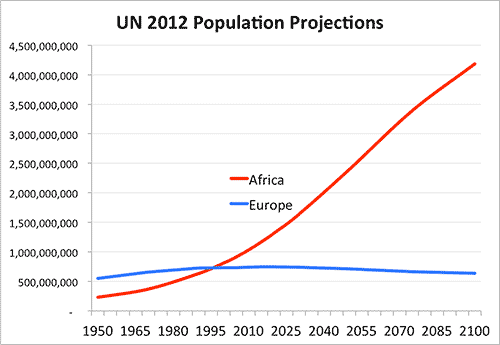World Fertility - The World's Most Important Graph
Mass immigration from islamic nations into Europe has resulted in a cultural onslaught that we haven't seen since before the Crusades. Indeed, that's why the Crusades were waged.
Current levels of immigration into Europe are but the tip of the iceberg. African and Mideast fertility is driving expansive population growth. As long as the gates of the European Union are open, Europe will serve as a migratory destination, absorbing endless numbers of excess population from other countries. It's the same with population growth in America.
In the April 23, 2017 Unz Review article, The World's Most Important Graph, Steve Sailer draws a graph showing the striking disparity between African and European population growth:
To understand what’s at stake regarding the Mediterranean, here’s a graph I made from the numbers in World Population Prospects: The 2012 Revision: Volume II: Demographic Profiles, which was published in 2013 by the Population Division of the Department of Economic and Social Affairs of the United Nations Secretariat.
Sailer explains this graph in more detail in his September 19, 2015 Unz Review article, The Graph That Explains the 2015 Migrant Crisis - and another graph that explains the migrant crises of 2016-2100:
The demographers of the United Nation’s Population Division have quietly released their World Population Prospects: 2015 Revision report.
Above is a graph I put together from their new data that explains much about the “Migrant Crisis” of 2015.
As you can see, way back in 1950, the population of the Middle East was only 18% as great as the population of Europe, while Sub-Saharan Africa was only 33% as large. Even in 2000, the Middle East had only 49% of the population of Europe, while Africa had almost caught up to Europe with 88% of its population.
But from 2000 to 2015, the Middle East added 124 million people, making it now 65% as populous as Europe.
In this century alone, Sub-Saharan Africa has added 320 million people, making it 130% as populated as Europe...
It turns out that while the total fertility rate in Africa is falling, it’s falling quite a bit more slowly than the U.N. had expected before its disturbing 2012 Revision.
And here’s my full graph of the U.N.’s 2015 Revision numbers:
... The U.N. now projects that, despite lower fertility in some Muslim countries such as Iran, the population of the Middle East will surpass that of Europe in 2045 and reach 937 million by 2100.
As for Sub-Saharan Africa, the U.N. foresees the population growing to 3,935,000,000 (3.9 billion and change) by 2100. (The total population of Africa and the Middle East will be 4,872,000,000.)
That’s probably not going to happen due to some combination of (A) intelligent self-restraint, (B) mass migration, and (C) Malthusian Nightmares (war, famine, disease, etc. etc.) keeping the population of Sub-Saharan Africa in 2100 from being more than six times as great as Europe, which would be an 18-fold increase in 150 years...
Sailer concludes his article with the pertinent observation:
Personally, I hope the reason that this graph doesn’t prove accurate is largely (A) intelligent self-restraint. But at present, white people don’t seem to be making much of an effort to facilitate and encourage reasonable family planning in Africa. Because that would be, you know, racist.
Related
See this interesting 5 minute interactive tutorial: Understanding Exponential Growth.
European Survival and the World's Most Important Graph, by Fred Elbel, CAIRCO, October 31, 2017.
Population Driven to Double by Mass Immigration
Exponential growth, doubling time, and the Rule of 70
Fertility and Population Momentum
The 2030 Great White Wave, by Dr. Brad Lyles, Canada Free Press, October 27, 2017.




